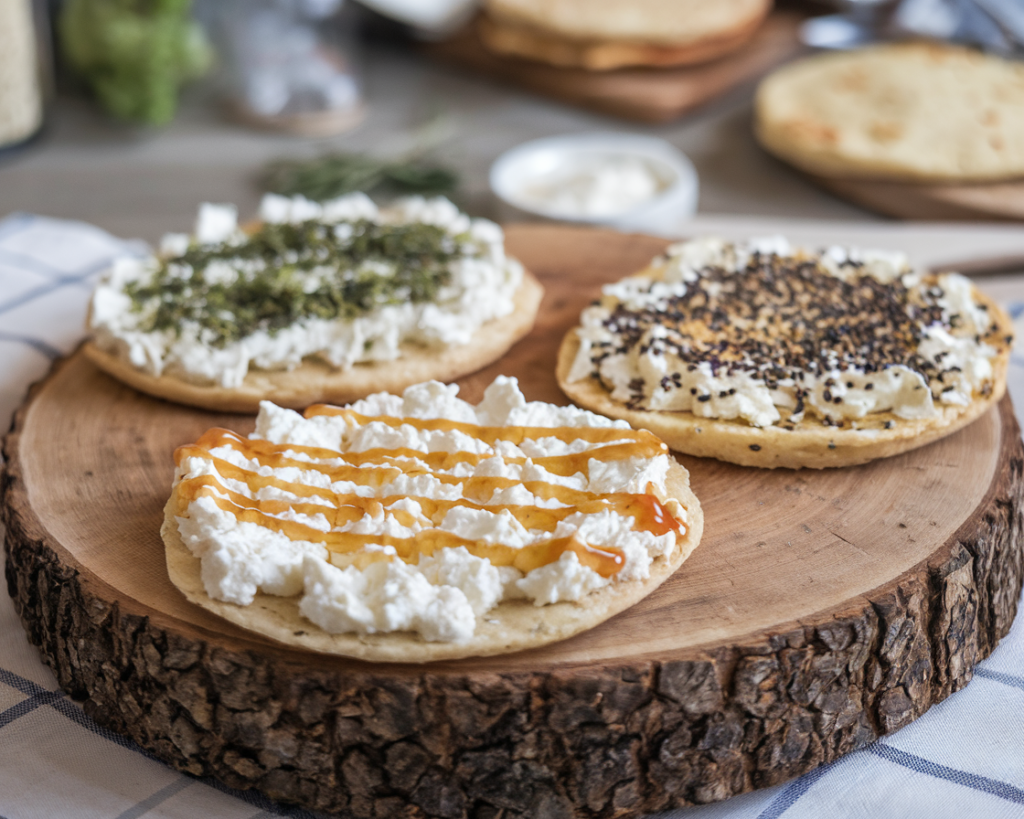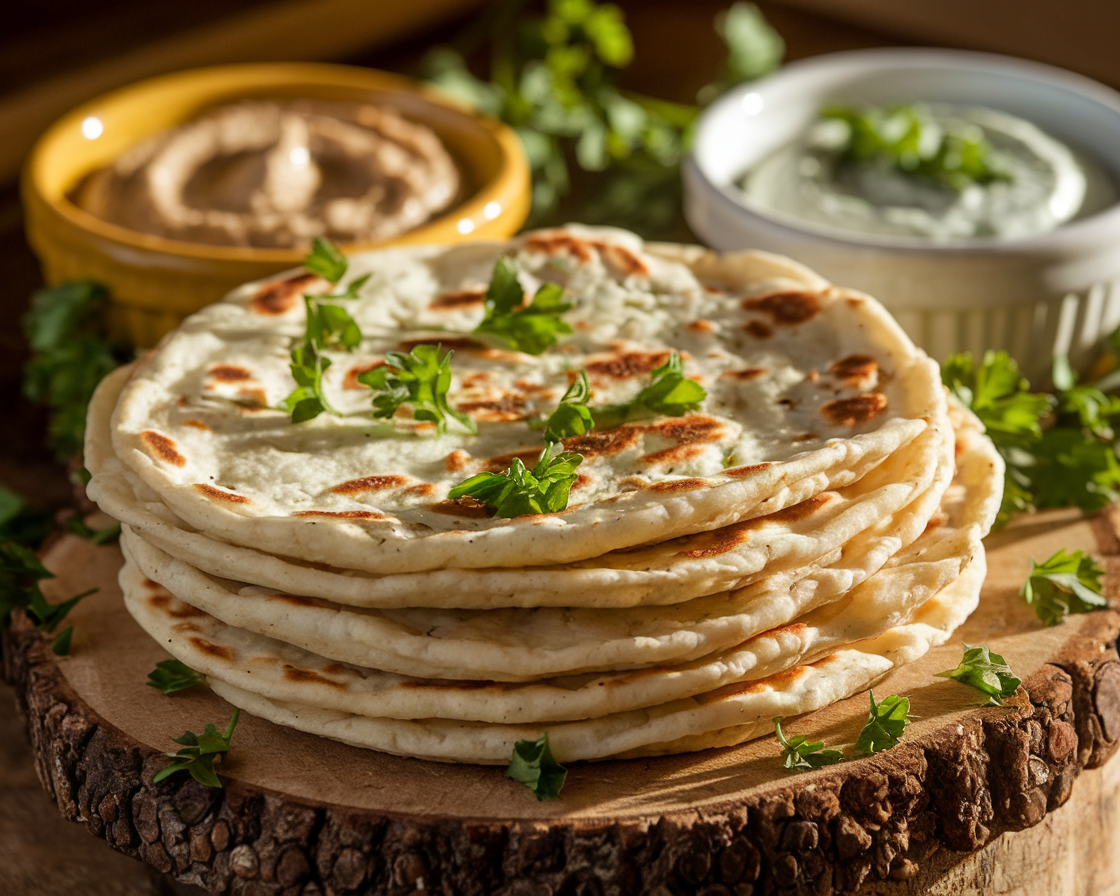Flatbread is one of the most versatile foods you can make. It’s a canvas for your favorite toppings, a companion to hearty soups, or even a quick snack on its own. Adding cottage cheese to your flatbread recipe takes it to the next level—infusing it with protein, moisture, and a subtle tangy flavor. Let’s dive into how you can create this delicious, healthy treat at home!
Introduction to Cottage Cheese Flatbread
What is Cottage Cheese Flatbread?
Cottage cheese flatbread is a simple, soft bread made with cottage cheese mixed into the dough. It’s a healthier alternative to traditional flatbreads, offering a lighter texture and higher nutritional value. This recipe is perfect for anyone looking for an easy yet creative way to elevate their bread game.
“Cottage cheese flatbread isn’t just bread—it’s a healthier, tastier option that’s perfect for any meal.”
Benefits of Using Cottage Cheese in Flatbread
Why cottage cheese? For starters, it’s packed with protein, making your flatbread more filling and nutritious. Its creamy texture keeps the bread soft and moist, while its mild flavor blends seamlessly with both sweet and savory toppings. Plus, cottage cheese is budget-friendly and widely available—what’s not to love?
Ingredients for Cottage Cheese Flatbread
Basic Ingredients for the Dough
To make cottage cheese flatbread, you’ll need just a handful of pantry staples:
| Ingredient | Quantity |
|---|---|
| All-Purpose Flour | 2 cups |
| Cottage Cheese (blended) | 1 cup |
| Baking Powder | 2 teaspoons |
| Salt | 1 teaspoon |
| Olive Oil | 2 tablespoons |
| Warm Water | ¼ cup |
Optional Add-Ins for Flavor and Texture
Want to customize your flatbread? Add chopped herbs like parsley, rosemary, or cilantro for a savory twist. For a sweeter option, mix in a tablespoon of honey or a sprinkle of cinnamon. Seeds like sesame or flax can be sprinkled on top for added crunch and nutrition.
Choosing the Right Cottage Cheese
Full-fat cottage cheese works best for flatbread as it adds richness and keeps the dough soft. If you prefer a smoother texture, blend the cottage cheese before mixing it into the dough.
“The quality of your cottage cheese sets the stage for the perfect flatbread—choose creamy and fresh for the best results.”
Step-by-Step Guide to Making Cottage Cheese Flatbread
Mixing and Preparing the Dough
- In a large mixing bowl, combine the flour, baking powder, and salt. Mix well to evenly distribute the dry ingredients.
- Add the blended cottage cheese, olive oil, and warm water to the bowl. Mix until the dough comes together into a slightly sticky ball.
- Transfer the dough to a floured surface and knead for 5-7 minutes until it becomes smooth and elastic.
Shaping and Cooking the Flatbread
- Divide the dough into 6-8 equal portions and roll each portion into a ball. Flatten each ball into a thin circle using a rolling pin or your hands.
- Heat a non-stick skillet or griddle over medium heat. Cook each flatbread for 2-3 minutes per side until golden brown spots appear. Keep the flatbreads warm in a clean kitchen towel as you cook the rest.
Finishing Touches and Serving Ideas
- Brush the cooked flatbreads with a light coating of olive oil or melted butter for extra flavor. Sprinkle with sea salt, chopped herbs, or a dusting of Parmesan cheese, depending on your preferences.
“Cooking flatbread on a skillet is like watching magic happen—soft dough transforms into golden, puffy perfection in minutes.”
Tips for Perfect Cottage Cheese Flatbread
How to Achieve the Ideal Dough Consistency
The consistency of your dough is key to soft and pliable flatbread. If the dough feels too sticky, sprinkle a little flour as you knead until it’s manageable. On the other hand, if the dough is too dry, add a teaspoon of water or olive oil to restore moisture. The goal is a smooth, elastic dough that’s easy to shape.
Cooking Flatbread Evenly on the Stove or Oven
For even cooking, preheat your skillet or griddle before adding the flatbread. Maintain medium heat to avoid burning the bread while ensuring it cooks through. If you’re baking the flatbread in the oven, use a pizza stone or preheated baking sheet for an evenly crisp texture. Flip flatbreads on the skillet or oven halfway through cooking for balanced browning.
Storing and Reheating Flatbread
Store leftover flatbread in an airtight container or wrap it in foil. It stays fresh at room temperature for up to two days or in the refrigerator for up to a week. Reheat in a skillet for a few seconds on each side or pop it in the oven at 300°F (150°C) for about 5 minutes.
Variations of Cottage Cheese Flatbread
Herb-Infused Cottage Cheese Flatbread
Add fresh or dried herbs like rosemary, thyme, or parsley to your dough for a fragrant, savory twist. You can even mix minced garlic into the dough for extra flavor. This variation pairs beautifully with soups, dips, or as a base for flatbread pizzas.
Sweet Cottage Cheese Flatbread with Honey
For a sweeter take, mix in a tablespoon of honey or a sprinkle of cinnamon into the dough. Once cooked, drizzle with additional honey and serve with fresh fruit or yogurt for a delightful breakfast or dessert option.

Gluten-Free Cottage Cheese Flatbread
For gluten-free flatbread, substitute the all-purpose flour with a gluten-free flour blend. Add a pinch of xanthan gum if the blend doesn’t already include it to improve elasticity. The result is a soft, gluten-free flatbread that everyone can enjoy.
Common Problems and Solutions
Why is My Flatbread Too Dense?
Dense flatbread can result from over-kneading the dough or using too much flour. Avoid adding excessive flour during kneading and ensure the baking powder is fresh for proper leavening.
Fixing Sticky Dough
Sticky dough can make it difficult to handle. To fix this, dust your hands and work surface with a light coating of flour. Knead until the dough becomes smooth and no longer sticks to your fingers.
Preventing Flatbread from Burning
Burnt flatbread often occurs when the skillet is too hot. Cook over medium heat and monitor the flatbread closely, flipping it as soon as golden spots appear.
“Remember, cooking flatbread is all about balance—control the heat, monitor the dough, and you’ll get perfect results every time.”
Pairing Suggestions for Cottage Cheese Flatbread
Toppings for Savory Flatbread
Cottage cheese flatbread serves as the perfect base for savory toppings. Try spreading hummus or tzatziki over the warm bread, then layering it with roasted vegetables, grilled chicken, or feta cheese. For a Mediterranean-inspired dish, top with olives, cherry tomatoes, and fresh basil. The mild tang of the flatbread complements bold flavors beautifully.
Sweet Pairings for Cottage Cheese Flatbread
For a sweet twist, spread cream cheese or ricotta on the flatbread and top with fresh berries, a drizzle of honey, and a sprinkle of chopped nuts. You can also try a cinnamon-sugar topping with melted butter for a dessert-like treat. Sweet toppings make this flatbread ideal for breakfast or an afternoon snack.
Cottage Cheese Flatbread for Special Occasions
Flatbread Appetizers for Parties
Cut your flatbread into smaller pieces and serve it as a base for appetizers. Add toppings like smoked salmon and dill, or bruschetta made with diced tomatoes and balsamic glaze. These bite-sized flatbreads are crowd-pleasers that are easy to prepare and customize.
Cottage Cheese Flatbread as a Side Dish
Pair your flatbread with hearty soups, stews, or salads as a flavorful side dish. It’s perfect for dipping into a rich tomato soup or mopping up the sauce from a beef stew. Its versatility makes it a must-have for family dinners or festive gatherings.
Baking Inspiration
Explore Creative Baking with Cottage Cheese Bread and Lemon Brownies
If you’re looking to expand your baking repertoire, cottage cheese and citrus desserts are two areas that promise delicious results. For a savory option, our Cottage Cheese Bread Recipe is a must-try. This soft, protein-rich bread combines the creaminess of cottage cheese with a perfectly golden crust, making it ideal for sandwiches, toasting, or simply enjoying with butter. It’s an easy, foolproof recipe that’s great for beginners and seasoned bakers alike.
On the sweeter side, don’t miss our guide on Freezing Lemon Brownies. Whether you’ve baked a large batch or are planning ahead, this article provides all the tips you need to freeze and store lemon brownies without compromising their zesty flavor and soft texture. Lemon brownies are a delightful, tangy treat that pair wonderfully with a cup of tea or coffee.
Combining these recipes allows you to create a well-rounded baking menu that covers both savory and sweet cravings. Pair a slice of cottage cheese bread with a hearty soup for lunch, and enjoy a lemon brownie for dessert. Both recipes are versatile and easy to make, ensuring you always have something delicious on hand
Frequently Asked Questions (FAQs)
Can I use low-fat cottage cheese for this recipe?
Yes, low-fat cottage cheese works well, but full-fat cottage cheese adds more richness and flavor. If you’re looking for a healthier option, low-fat is a great alternative.
How do I store leftover flatbread?
Store your leftover flatbread in an airtight container or wrap it in foil. It will stay fresh at room temperature for up to 2 days or in the refrigerator for up to a week. Reheat on a skillet or in the oven to restore its softness.
Can I freeze cottage cheese flatbread?
Absolutely! Freeze flatbreads in a sealed bag or container with parchment paper between each piece to prevent sticking. To reheat, thaw them at room temperature and warm them in a skillet or oven.
What can I serve with cottage cheese flatbread?
Cottage cheese flatbread pairs well with hummus, tzatziki, or guacamole for dipping. It also complements soups, salads, and stews. Sweet toppings like honey or cream cheese are perfect for a dessert-like twist.
Can I make gluten-free cottage cheese flatbread?
Yes, substitute all-purpose flour with a gluten-free flour blend. Add a pinch of xanthan gum if the flour blend doesn’t include it for better dough elasticity.
Conclusion: The Versatility and Benefits of Cottage Cheese Flatbread
Cottage cheese flatbread is a recipe that combines simplicity, flavor, and nutrition. Its soft texture and mild tang make it a versatile choice for any meal, whether you’re preparing a quick snack, a savory appetizer, or a hearty side dish. With endless topping and pairing options, this flatbread is a canvas for creativity. Plus, the added protein and moisture from cottage cheese mean you’re not just making bread—you’re making a healthier, more satisfying version of a classic. So grab your ingredients and get cooking—your next culinary masterpiece is just a skillet away.
“Flatbread with cottage cheese isn’t just bread—it’s a deliciously versatile creation waiting for your personal touch.”

